Main Page: Difference between revisions
From Sleeping Dragons (Board Game)
Levy Wright (talk | contribs) pawn and tokin pic added |
Levy Wright (talk | contribs) fix |
||
| (26 intermediate revisions by 3 users not shown) | |||
| Line 2: | Line 2: | ||
=== Current Version: Alpha 4.1 === | === Current Version: Alpha 4.1 === | ||
''(Engine in development, Magic does not work yet, pieces do not have spells. You can currently (Alpha 4.1) play a colorless version of the game only. This is recommended for beginners to the game anyway! =])'' | |||
Play now! http://www.sleepingdragons.online/game/ | |||
=== How to Play === | === How to Play === | ||
Sleeping Dragons is a board game played on a 10x10 grid by two players. Each player has their own personalized "Army" of pieces which are placed on squares of their own choice before the game begins. The board is actually made up of two separate 5x10 boards, each half is taken by one player to set up their Army's piece positions, after both players are ready the boards are brought together, and a coin flip determines who takes the first turn. | |||
Sleeping Dragons is a Chess-like game with influences from Magic: The Gathering, but unlike Chess there is no Checkmate. The game is not lost when a Sleeping Dragon dies, but its owner will no longer have it as a Mana source, and could easily be overwhelmed by magic. However if you manage to get a Pawn or Tokin to the opponent's back row you may reanimate your Dragon (see below in "Back Rank Reanimation"). | |||
The object of the game is to destroy your opponent's forces. The game is won when all of your opponent's pieces have been captured, or when they admit defeat and resign. The game is a Draw if agreed by both players, if 50 moves go by with no pieces dying, or if the same position is repeated on the board 5 times. | |||
==== Turns and Turn Phases ==== | ==== Turns and Turn Phases ==== | ||
Each Turn consists of 3 main phases in this order: Magic Phase, Movement Phase, and End Phase. | |||
===== Magic Phase ===== | ===== Magic Phase ===== | ||
At the start of your Magic Phase you will gain 2 Mana if you have a Sleeping Dragon on the board, 3 Mana if you have an Awakened Dragon on the board, and 1 Mana if you have an Effigy on board. | |||
After this if you have enough Mana, you may choose to cast one of your piece's spells. While any type of spell may be cast during your Magic Phase, only Instant type spells may be cast during other phases. | |||
After this your Movement Phase begins. | |||
===== Movement Phase ===== | ===== Movement Phase ===== | ||
During your Movement Phase you must move one of your pieces. If the movement is a piece capture, during your End Phase you will gain 2 Mana (1 for Pawns / Tokins, and 6 for an Awakened Dragon). After movement is complete the turn moves to your End Phase. | |||
===== End Phase ===== | ===== End Phase ===== | ||
During your End Phase, the effects of spells may either resolve, or have their duration counted down until it resolves on a later End Phase. If a piece was captured during the turn's Movement Phase you will gain Mana accordingly at this time. | |||
==== Mana ==== | ==== Mana ==== | ||
Mana is used for two things: awakening your Dragon, and casting spells. | |||
It is generated by Sleeping Dragons (2MPT), Awakened Dragons (3MPT), Effigy piece (1MPT). | |||
It is awarded in different amounts by capturing pieces. | |||
Capturing an Awakened Dragon awards you 6 Mana. | |||
Capturing a Sleeping Dragon or Piece awards you 2 Mana. | |||
Capturing a Pawn or Tokin awards you 1 Mana. | |||
Killing any piece with a spell or spell's effect <u>does not</u> award you any Mana. | |||
==== Casting Spells ==== | ==== Casting Spells ==== | ||
Instant type spells may be cast anytime you have the Mana, either in response to an action made by you or your opponent, or at the end of any turn phase. | |||
Any other type of spell is "sorcery speed" and may only be cast during your own Magic Phase. | |||
==== Targeting ==== | ==== Targeting ==== | ||
Magic Targeting works in one of two ways. | |||
For the base cost of the spell, I.E. 3 Mana, the piece casting the spell may target any square it could already move to in a straight line (no jumping or alternating motion targeting). However many spells have costs like this: 3 (+1) - this means for 3 it can target any square it could already move to, and for each +1 additional Mana you pay it may target +1 square farther in the same direction of its movement. If it were 3 (+2) it would be +2 additional Mana for every 1 square farther you want to target. This does not allow the spell to target more than one square, it only extends the range at which it can target. There is no limit on how many times you can pay to extend the range when casting as long as you have the Mana to do it. | |||
A few spells have unique targeting specified in their own rules. Some cast from the square the casting piece currently occupies. | |||
==== Mana Strategy ==== | |||
There are 4 main strategies you can choose to employ: | |||
1: Conservative, strictly saving Mana until you can awaken your Dragon. This means casting no spells, or only what is necessary, until after your Dragon is awakened. Afterwards your MPT (Mana Per Turn) increases from 2 to 3, allowing you to cast spells more often. | |||
2: Hybrid, keep a priority of saving Mana, but also look for spell / movement combos. Use spells in moderation and try to build up Mana to awaken your Dragon. | |||
3: Spellcaster, disregard the idea of ever awakening your Dragon at all, and use Mana to cast spells every turn or every other turn instead. Always look for spell / movement combination attacks. | |||
4: Trickster, strictly saving your Mana so it seems your goal is to awaken your Dragon, but secretly looking for double spell / movement combinations to surprise attack in a devastating way. Or if no combinations come up, just awaken your Dragon and let it do its thing. | |||
==== A Sleeping Dragon ==== | |||
What is a Sleeping Dragon anyway? | |||
When you select the pieces in your Army you will have many Dragon options to choose from! Each of them have overpowered movesets and powerful magic, many of them have unique spells too powerful for other pieces to have. They begin the game asleep, which means they cannot move, and only generate 2 Mana Per Turn (MPT). Each Dragon has a unique Awakening Cost, which is the amount of Mana required to awaken it. This allows it to move and cast spells like any other piece, and it will now generate you 3 MPT. However if your Dragon dies it will not be there to continue generating Mana for you. | |||
Dragons are the Queens of this game, but in their power they hold value you must still protect. | |||
==== Pawns and Tokins ==== | |||
When you select the pieces in your Army you will also get to choose either Pawns or Tokins to lead your charge, to create your structure, to attack and defend with. | |||
Pawns move diagonally-forward 1 square only (depicted below in movesets), and cannot move back. Their ability to move two different forward directions is strong for attacking, and difficult to stop when they get past enemy lines. | |||
Tokins move forward or backward 1 square only (depicted below). Their backward moving ability is powerful and good for defending. | |||
===== Back Rank Reanimation ===== | |||
When a Pawn or Tokin reaches the opponent's back rank it will die on its controller's end phase, at that time that player may choose any dead piece they originally controlled, and reanimate it anywhere on their back three rows which is not currently an occupied space. | |||
==== Getting Started Playing ==== | |||
A standard game of Sleeping Dragons can be a lot to process when you're starting out. It is highly ''recommended'' new players first try a Colorless Duel format to learn and get used to the way different pieces move. Next try some Colorless Standard format games until you're comfortable. This is almost just like a normal game, except there is no magic. After you get comfortable playing Colorless Standard, try Two Heroes Standard or Mono-Color Standard. | |||
===== Selecting Your Army ===== | |||
Like Chess, Sleeping Dragons is a game of near infinite possibility. You can very much choose the kind of play style that suits you best and tune your Army toward that. Want to be incredibly aggressive, launching attacks and magic combinations every other turn? You can do that. Want to shut down everything your opponent does with magic, and slowly take control of the entire board? Go for it. | |||
When selecting your Army's pieces consider how each one may coordinate with another. A Chariot and a General work extremely well together as an attacking pair, for example. | |||
(Normal types) | |||
The General moves like a Silver General from Shogi, except two spaces instead of one. Diagonally two, or forward two. It makes a great defender or attacker, and support for attacks with other pieces. | |||
The Hare is tricky and elusive, but has close-up blind spots. | |||
The Horse is a Chess Knight who can also move diagonally a single space. It is a powerful and tricky hybrid piece. | |||
The Bullfrog jumps over one space in any direction, or moves back one. It too is elusive, but with close-up blind spots. | |||
The Bear is an excellent defender, and unsuspecting attacker or support piece. It coordinates very well with the General. Counterpart piece to the Chariot. | |||
The Chariot is an excellent attacker, and unsuspecting defender or support piece. It coordinates very well with the General. | |||
(Specialty types) | |||
The Mage has short movement range, but compensates with excellent magic. Most colored armies should probably have a Mage. | |||
The Battlemage has a great moveset and range, and excellent magic which is typically offensive. This piece is a strong "all-rounder" you won't regret using. | |||
The Snake is very tricky, and can infiltrate defenses or escape and retreat with ease, combined with deadly magic, you can't go wrong with a Snake. | |||
The Leopard has a powerful and somewhat tricky moveset. It shines most when the board is more open. Counterpart piece to the Wolf. | |||
The Wolf is powerful and tricky, and shines most when the board is open. | |||
The Battlemage, Snake, Leopard, and Wolf are the "power pieces" of the game. The Queens. The Mage is the Army's protector that annoys your enemy and makes your goals easier to achieve, but use them carefully as they cannot retreat quickly. | |||
When you have a good idea of the type of strategy you want to go for, and have selected the pieces for your Army, it's time to choose between Pawns or Tokins. One may fit your strategy best. I.E. if you know you're going to play defensively, Tokins are probably your best choice. But it is also important to consider the movement of your Army in this decision. Do most of your pieces move diagonally? Choosing Pawns means those also move Diagonally, and your opponent could easily exploit weaknesses on straight lines. If most of them have diagonal movements, Tokins are a good choice to round out your weaknesses. Conversely if most of your pieces have orthogonal movement (side to side, and up and down) you may want to choose Pawns for the same reason, to cover more diagonal weaknesses. | |||
If you're playing a multi-colored format this is the point you want to choose color variants of your pieces. Which variation has the best spells to suit your strategy? Blue variations tend to have magic focused on Buffing piece movement, Sorcery and Ice elemental, and Counter magic. Red variations have magic focused on Fire sorcery, different kinds of piece buffs, it can be very aggressive. Yellow uses Debuff spells, Toxic sorcery, and anti-magic. This may suit aggressive or defensive strategies well, and does not have elements that interact with Fire or Ice. | |||
Alternatively you could look through all the color variations and select your pieces based exclusively on the spells they cast, then look for the best way to arrange those pieces. This is different from the order outlined above, but completely valid if you are trying to focus more on spell usage. | |||
=== | == Official Game Formats: == | ||
( | |||
=== [[Colorless Duel (Format)|Colorless Duel]] === | |||
-No more than 2 copies of the same Piece type allowed per army | |||
-No Specialty piece types allowed | |||
-4 Colorless Pieces, and 5 Pawns or Tokins | |||
Note: The Duel is won when all your opponent's pieces are dead, or when they resign. | |||
=== [[Standard Duel (Format)|Standard Duel]] === | |||
-No more than 2 copies of the same Piece type allowed per army | |||
-No Specialty piece types allowed | |||
-2 different Color variants allowed per army | |||
-2 Colored Pieces, and 2 Colorless Pieces, and 5 Pawns or Tokins | |||
-up to 1 Specialty Type Pieces allowed per army | |||
-1 Effigy | |||
Note: This dueling format is the only one with this rule: The game is when when your opponent's Effigy is destroyed, or when they resign. | |||
=== [[Royal Duel (Format)|Royal Duel]] === | |||
-No more than 2 copies of the same Piece type allowed per army | |||
-No Specialty piece types allowed | |||
-Each player begins the game with 16 Mana | |||
-3 different Color Variants allowed per army | |||
-4 Colored Pieces, and 5 Pawns or Tokins | |||
-No Dragons or Effigies allowed | |||
Note: The game is won when all your opponent's pieces are dead. | |||
=== [[Colorless Standard (Format)|Colorless Standard]] === | |||
-No more than 2 copies of the same Piece type allowed per army | |||
-7 Colorless Pieces, and 10 Pawns or Tokins | |||
-Up to 2 Specialty Type Pieces allowed per army | |||
-1 Colorless Dragon | |||
Note: The game is won when all your opponent's Pieces and Pawns or Tokins are dead, or when they resign. | |||
==== Mono-Color Standard ==== | |||
-No more than 2 copies of the same Piece type allowed per army | |||
-1 type Color variation only allowed per army | |||
-Up to 2 Specialty Type Pieces allowed per army | |||
-7 Pieces, and 10 Pawns or Tokins | |||
-1 Dragon (must match color identity with your color of choice, or be colorless) | |||
Note: The game is won when all your opponent's Pieces and Pawns or Tokins are dead, or when they resign. | |||
=== [[Standard (Format)|Standard]] === | |||
-No more than 2 copies of the same Piece type allowed per army | |||
-2 different Color Variants allowed per army | |||
-Up to 2 Specialty Type Pieces allowed per army | |||
-7 Pieces, and 10 Pawns or Tokins | |||
-1 Dragon (must match color identity with one of your pieces, or be colorless) | |||
Note: The game is won when all your opponent's Pieces and Pawns or Tokins are dead, or when they resign. | |||
==== Two Heroes Standard ==== | |||
-No more than 2 copies of the same Piece type allowed per army | |||
-Up to 2 color variations per army. | |||
-Up to 2 Specialty Type Pieces allowed per army | |||
-5 Colorless pieces, 2 color variation pieces, and 10 Pawns or Tokins | |||
-1 Dragon (must match color identity with one of your pieces, or be colorless) | |||
Note: The game is won when all your opponent's Pieces and Pawns or Tokins are dead, or when they resign. | |||
=== [[Royal Standard (Format)|Royal Standard]] === | |||
-No more than 2 copies of the same Piece type allowed per army | |||
-Up to 3 different Color Variants allowed per army | |||
-Up to 3 Specialty Type Pieces allowed per army | |||
-8 Pieces, and 10 Pawns or Tokins | |||
-1 Dragon (must match color identity with one of your pieces, or be colorless) | |||
Note: The game is won when your opponent's Dragon is dead. | |||
=== [[Double Dragons Standard (Format)|Double Dragons Standard]] === | |||
-No more than 2 copies of the same Piece type allowed per army | |||
-Up to 2 different Color variants allowed per army | |||
-Up to 3 Specialty Type Pieces allowed per army | |||
-7 Pieces, and 10 Pawns or Tokin | |||
-2 Dragons (Each must match color identity with one of your pieces, or be colorless) | |||
Note: Higher MPT means Dragon(s) awakened sooner and many more spells to cast more often. The game is won when both of your opponent's Dragons are dead. | |||
=== [[Double Effigy Standard (Format)|Double Effigy Standard]] === | |||
-No more than 2 copies of the same Piece type allowed per army | |||
-Up to 2 different Color Variants allowed per army | |||
-Up to 2 Specialty Type Pieces allowed per army | |||
-7 Pieces, and 10 Pawns or Tokins | |||
-2 Effigies | |||
Note: This plays much like Standard format, but the dynamic changes. There is no Dragon to awaken, but you have 2 or 3 Effigies to protect, and your opponent's to try and destroy. The game is won when all your opponent's Effigies are destroyed. | |||
== Pieces, and how they move: == | |||
=== Pawns and Tokins === | |||
[[File:Pawn and Tokin.png|left|thumb]] | |||
| Line 135: | Line 268: | ||
| Line 142: | Line 273: | ||
=== Normal Pieces === | |||
(Release Version a4.1) | |||
==== | ==== General ==== | ||
[[File: | [[File:General Moveset.png|thumb|center]] | ||
==== Rabbit ==== | |||
[[File:10 Rabbit.png|thumb|center]] | |||
==== Horse ==== | |||
[[File:Horse.png|thumb|center]] | |||
==== Bullfrog ==== | |||
[[File:Bullfrog.png|thumb|center]] | |||
==== Bear ==== | |||
[[File:Bear.png|thumb|center]] | |||
==== Chariot ==== | |||
[[File:Chariot.png|thumb|center]] | |||
=== Specialty Pieces === | |||
(Release Version a4.1) | |||
==== Mage ==== | |||
| Line 164: | Line 308: | ||
==== Battlemage ==== | |||
[[File:Battlemage.png|left|thumb]] | |||
==== | ==== Crane ==== | ||
[[File:Crane.png|center|thumb]] | |||
==== Snake ==== | |||
==== Leopard ==== | |||
==== Wolf ==== | |||
==== Effigy ==== | ==== Effigy ==== | ||
== Dragons == | |||
(Release Version a4.1) | (Release Version a4.1) | ||
==== Colorless Dragon ==== | ==== Colorless Dragon ==== | ||
Awakening Cost: | |||
==== Ice Dragon ==== | ==== Ice Dragon ==== | ||
Awakening Cost: | |||
(Spells pending Alpha 4.5 update, coming soon) | |||
==== Fire Dragon ==== | ==== Fire Dragon ==== | ||
Awakening Cost: | |||
(Spells pending Alpha 4.5 update, coming soon) | |||
==== Hydra Dragon ==== | ==== Hydra Dragon ==== | ||
Awakening Cost: | |||
(Spells pending Alpha 4.5 update, coming soon) | |||
==== Effigy of a Dragon ==== | ==== Effigy of a Dragon ==== | ||
Used instead of a Dragon in your Army. The Effigy of a Dragon produces 3 Mana Per Turn for its controller. It cannot move, and is not awakened. | |||
== Color Variants == | |||
(Release Version a4.1) | (Release Version a4.1) | ||
==== Colorless Variants ==== | |||
==== Blue Variants ==== | ==== Blue Variants ==== | ||
| Line 201: | Line 369: | ||
== All Spells == | |||
(Release Version A4.1) | (Release Version A4.1) | ||
Latest revision as of 18:23, 24 April 2024
Sleeping Dragons (Board Game)[edit | edit source]
Current Version: Alpha 4.1[edit | edit source]
(Engine in development, Magic does not work yet, pieces do not have spells. You can currently (Alpha 4.1) play a colorless version of the game only. This is recommended for beginners to the game anyway! =])
Play now! http://www.sleepingdragons.online/game/
How to Play[edit | edit source]
Sleeping Dragons is a board game played on a 10x10 grid by two players. Each player has their own personalized "Army" of pieces which are placed on squares of their own choice before the game begins. The board is actually made up of two separate 5x10 boards, each half is taken by one player to set up their Army's piece positions, after both players are ready the boards are brought together, and a coin flip determines who takes the first turn.
Sleeping Dragons is a Chess-like game with influences from Magic: The Gathering, but unlike Chess there is no Checkmate. The game is not lost when a Sleeping Dragon dies, but its owner will no longer have it as a Mana source, and could easily be overwhelmed by magic. However if you manage to get a Pawn or Tokin to the opponent's back row you may reanimate your Dragon (see below in "Back Rank Reanimation").
The object of the game is to destroy your opponent's forces. The game is won when all of your opponent's pieces have been captured, or when they admit defeat and resign. The game is a Draw if agreed by both players, if 50 moves go by with no pieces dying, or if the same position is repeated on the board 5 times.
Turns and Turn Phases[edit | edit source]
Each Turn consists of 3 main phases in this order: Magic Phase, Movement Phase, and End Phase.
Magic Phase[edit | edit source]
At the start of your Magic Phase you will gain 2 Mana if you have a Sleeping Dragon on the board, 3 Mana if you have an Awakened Dragon on the board, and 1 Mana if you have an Effigy on board.
After this if you have enough Mana, you may choose to cast one of your piece's spells. While any type of spell may be cast during your Magic Phase, only Instant type spells may be cast during other phases.
After this your Movement Phase begins.
Movement Phase[edit | edit source]
During your Movement Phase you must move one of your pieces. If the movement is a piece capture, during your End Phase you will gain 2 Mana (1 for Pawns / Tokins, and 6 for an Awakened Dragon). After movement is complete the turn moves to your End Phase.
End Phase[edit | edit source]
During your End Phase, the effects of spells may either resolve, or have their duration counted down until it resolves on a later End Phase. If a piece was captured during the turn's Movement Phase you will gain Mana accordingly at this time.
Mana[edit | edit source]
Mana is used for two things: awakening your Dragon, and casting spells.
It is generated by Sleeping Dragons (2MPT), Awakened Dragons (3MPT), Effigy piece (1MPT).
It is awarded in different amounts by capturing pieces.
Capturing an Awakened Dragon awards you 6 Mana.
Capturing a Sleeping Dragon or Piece awards you 2 Mana.
Capturing a Pawn or Tokin awards you 1 Mana.
Killing any piece with a spell or spell's effect does not award you any Mana.
Casting Spells[edit | edit source]
Instant type spells may be cast anytime you have the Mana, either in response to an action made by you or your opponent, or at the end of any turn phase.
Any other type of spell is "sorcery speed" and may only be cast during your own Magic Phase.
Targeting[edit | edit source]
Magic Targeting works in one of two ways.
For the base cost of the spell, I.E. 3 Mana, the piece casting the spell may target any square it could already move to in a straight line (no jumping or alternating motion targeting). However many spells have costs like this: 3 (+1) - this means for 3 it can target any square it could already move to, and for each +1 additional Mana you pay it may target +1 square farther in the same direction of its movement. If it were 3 (+2) it would be +2 additional Mana for every 1 square farther you want to target. This does not allow the spell to target more than one square, it only extends the range at which it can target. There is no limit on how many times you can pay to extend the range when casting as long as you have the Mana to do it.
A few spells have unique targeting specified in their own rules. Some cast from the square the casting piece currently occupies.
Mana Strategy[edit | edit source]
There are 4 main strategies you can choose to employ:
1: Conservative, strictly saving Mana until you can awaken your Dragon. This means casting no spells, or only what is necessary, until after your Dragon is awakened. Afterwards your MPT (Mana Per Turn) increases from 2 to 3, allowing you to cast spells more often.
2: Hybrid, keep a priority of saving Mana, but also look for spell / movement combos. Use spells in moderation and try to build up Mana to awaken your Dragon.
3: Spellcaster, disregard the idea of ever awakening your Dragon at all, and use Mana to cast spells every turn or every other turn instead. Always look for spell / movement combination attacks.
4: Trickster, strictly saving your Mana so it seems your goal is to awaken your Dragon, but secretly looking for double spell / movement combinations to surprise attack in a devastating way. Or if no combinations come up, just awaken your Dragon and let it do its thing.
A Sleeping Dragon[edit | edit source]
What is a Sleeping Dragon anyway?
When you select the pieces in your Army you will have many Dragon options to choose from! Each of them have overpowered movesets and powerful magic, many of them have unique spells too powerful for other pieces to have. They begin the game asleep, which means they cannot move, and only generate 2 Mana Per Turn (MPT). Each Dragon has a unique Awakening Cost, which is the amount of Mana required to awaken it. This allows it to move and cast spells like any other piece, and it will now generate you 3 MPT. However if your Dragon dies it will not be there to continue generating Mana for you.
Dragons are the Queens of this game, but in their power they hold value you must still protect.
Pawns and Tokins[edit | edit source]
When you select the pieces in your Army you will also get to choose either Pawns or Tokins to lead your charge, to create your structure, to attack and defend with.
Pawns move diagonally-forward 1 square only (depicted below in movesets), and cannot move back. Their ability to move two different forward directions is strong for attacking, and difficult to stop when they get past enemy lines.
Tokins move forward or backward 1 square only (depicted below). Their backward moving ability is powerful and good for defending.
Back Rank Reanimation[edit | edit source]
When a Pawn or Tokin reaches the opponent's back rank it will die on its controller's end phase, at that time that player may choose any dead piece they originally controlled, and reanimate it anywhere on their back three rows which is not currently an occupied space.
Getting Started Playing[edit | edit source]
A standard game of Sleeping Dragons can be a lot to process when you're starting out. It is highly recommended new players first try a Colorless Duel format to learn and get used to the way different pieces move. Next try some Colorless Standard format games until you're comfortable. This is almost just like a normal game, except there is no magic. After you get comfortable playing Colorless Standard, try Two Heroes Standard or Mono-Color Standard.
Selecting Your Army[edit | edit source]
Like Chess, Sleeping Dragons is a game of near infinite possibility. You can very much choose the kind of play style that suits you best and tune your Army toward that. Want to be incredibly aggressive, launching attacks and magic combinations every other turn? You can do that. Want to shut down everything your opponent does with magic, and slowly take control of the entire board? Go for it.
When selecting your Army's pieces consider how each one may coordinate with another. A Chariot and a General work extremely well together as an attacking pair, for example.
(Normal types)
The General moves like a Silver General from Shogi, except two spaces instead of one. Diagonally two, or forward two. It makes a great defender or attacker, and support for attacks with other pieces.
The Hare is tricky and elusive, but has close-up blind spots.
The Horse is a Chess Knight who can also move diagonally a single space. It is a powerful and tricky hybrid piece.
The Bullfrog jumps over one space in any direction, or moves back one. It too is elusive, but with close-up blind spots.
The Bear is an excellent defender, and unsuspecting attacker or support piece. It coordinates very well with the General. Counterpart piece to the Chariot.
The Chariot is an excellent attacker, and unsuspecting defender or support piece. It coordinates very well with the General.
(Specialty types)
The Mage has short movement range, but compensates with excellent magic. Most colored armies should probably have a Mage.
The Battlemage has a great moveset and range, and excellent magic which is typically offensive. This piece is a strong "all-rounder" you won't regret using.
The Snake is very tricky, and can infiltrate defenses or escape and retreat with ease, combined with deadly magic, you can't go wrong with a Snake.
The Leopard has a powerful and somewhat tricky moveset. It shines most when the board is more open. Counterpart piece to the Wolf.
The Wolf is powerful and tricky, and shines most when the board is open.
The Battlemage, Snake, Leopard, and Wolf are the "power pieces" of the game. The Queens. The Mage is the Army's protector that annoys your enemy and makes your goals easier to achieve, but use them carefully as they cannot retreat quickly.
When you have a good idea of the type of strategy you want to go for, and have selected the pieces for your Army, it's time to choose between Pawns or Tokins. One may fit your strategy best. I.E. if you know you're going to play defensively, Tokins are probably your best choice. But it is also important to consider the movement of your Army in this decision. Do most of your pieces move diagonally? Choosing Pawns means those also move Diagonally, and your opponent could easily exploit weaknesses on straight lines. If most of them have diagonal movements, Tokins are a good choice to round out your weaknesses. Conversely if most of your pieces have orthogonal movement (side to side, and up and down) you may want to choose Pawns for the same reason, to cover more diagonal weaknesses.
If you're playing a multi-colored format this is the point you want to choose color variants of your pieces. Which variation has the best spells to suit your strategy? Blue variations tend to have magic focused on Buffing piece movement, Sorcery and Ice elemental, and Counter magic. Red variations have magic focused on Fire sorcery, different kinds of piece buffs, it can be very aggressive. Yellow uses Debuff spells, Toxic sorcery, and anti-magic. This may suit aggressive or defensive strategies well, and does not have elements that interact with Fire or Ice.
Alternatively you could look through all the color variations and select your pieces based exclusively on the spells they cast, then look for the best way to arrange those pieces. This is different from the order outlined above, but completely valid if you are trying to focus more on spell usage.
Official Game Formats:[edit | edit source]
Colorless Duel[edit | edit source]
-No more than 2 copies of the same Piece type allowed per army
-No Specialty piece types allowed
-4 Colorless Pieces, and 5 Pawns or Tokins
Note: The Duel is won when all your opponent's pieces are dead, or when they resign.
Standard Duel[edit | edit source]
-No more than 2 copies of the same Piece type allowed per army
-No Specialty piece types allowed
-2 different Color variants allowed per army
-2 Colored Pieces, and 2 Colorless Pieces, and 5 Pawns or Tokins
-up to 1 Specialty Type Pieces allowed per army
-1 Effigy
Note: This dueling format is the only one with this rule: The game is when when your opponent's Effigy is destroyed, or when they resign.
Royal Duel[edit | edit source]
-No more than 2 copies of the same Piece type allowed per army
-No Specialty piece types allowed
-Each player begins the game with 16 Mana
-3 different Color Variants allowed per army
-4 Colored Pieces, and 5 Pawns or Tokins
-No Dragons or Effigies allowed
Note: The game is won when all your opponent's pieces are dead.
Colorless Standard[edit | edit source]
-No more than 2 copies of the same Piece type allowed per army
-7 Colorless Pieces, and 10 Pawns or Tokins
-Up to 2 Specialty Type Pieces allowed per army
-1 Colorless Dragon
Note: The game is won when all your opponent's Pieces and Pawns or Tokins are dead, or when they resign.
Mono-Color Standard[edit | edit source]
-No more than 2 copies of the same Piece type allowed per army
-1 type Color variation only allowed per army
-Up to 2 Specialty Type Pieces allowed per army
-7 Pieces, and 10 Pawns or Tokins
-1 Dragon (must match color identity with your color of choice, or be colorless)
Note: The game is won when all your opponent's Pieces and Pawns or Tokins are dead, or when they resign.
Standard[edit | edit source]
-No more than 2 copies of the same Piece type allowed per army
-2 different Color Variants allowed per army
-Up to 2 Specialty Type Pieces allowed per army
-7 Pieces, and 10 Pawns or Tokins
-1 Dragon (must match color identity with one of your pieces, or be colorless)
Note: The game is won when all your opponent's Pieces and Pawns or Tokins are dead, or when they resign.
Two Heroes Standard[edit | edit source]
-No more than 2 copies of the same Piece type allowed per army
-Up to 2 color variations per army.
-Up to 2 Specialty Type Pieces allowed per army
-5 Colorless pieces, 2 color variation pieces, and 10 Pawns or Tokins
-1 Dragon (must match color identity with one of your pieces, or be colorless)
Note: The game is won when all your opponent's Pieces and Pawns or Tokins are dead, or when they resign.
Royal Standard[edit | edit source]
-No more than 2 copies of the same Piece type allowed per army
-Up to 3 different Color Variants allowed per army
-Up to 3 Specialty Type Pieces allowed per army
-8 Pieces, and 10 Pawns or Tokins
-1 Dragon (must match color identity with one of your pieces, or be colorless)
Note: The game is won when your opponent's Dragon is dead.
Double Dragons Standard[edit | edit source]
-No more than 2 copies of the same Piece type allowed per army
-Up to 2 different Color variants allowed per army
-Up to 3 Specialty Type Pieces allowed per army
-7 Pieces, and 10 Pawns or Tokin
-2 Dragons (Each must match color identity with one of your pieces, or be colorless)
Note: Higher MPT means Dragon(s) awakened sooner and many more spells to cast more often. The game is won when both of your opponent's Dragons are dead.
Double Effigy Standard[edit | edit source]
-No more than 2 copies of the same Piece type allowed per army
-Up to 2 different Color Variants allowed per army
-Up to 2 Specialty Type Pieces allowed per army
-7 Pieces, and 10 Pawns or Tokins
-2 Effigies
Note: This plays much like Standard format, but the dynamic changes. There is no Dragon to awaken, but you have 2 or 3 Effigies to protect, and your opponent's to try and destroy. The game is won when all your opponent's Effigies are destroyed.
Pieces, and how they move:[edit | edit source]
Pawns and Tokins[edit | edit source]
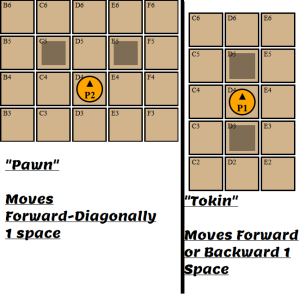
Normal Pieces[edit | edit source]
(Release Version a4.1)
General[edit | edit source]
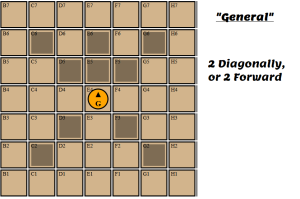
Rabbit[edit | edit source]
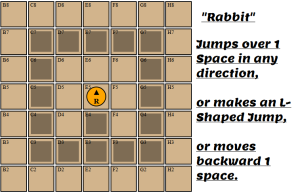
Horse[edit | edit source]
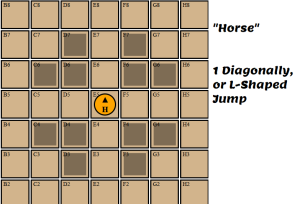
Bullfrog[edit | edit source]
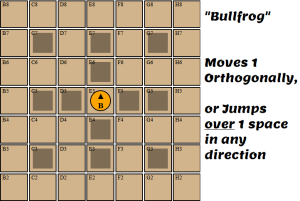
Bear[edit | edit source]
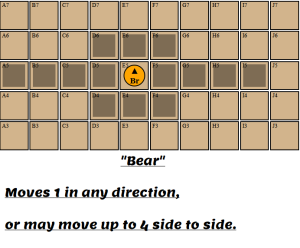
Chariot[edit | edit source]
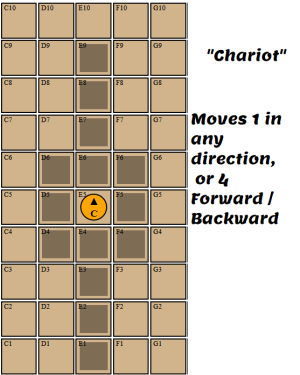
Specialty Pieces[edit | edit source]
(Release Version a4.1)
Mage[edit | edit source]
Battlemage[edit | edit source]
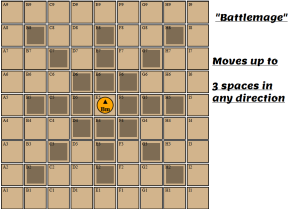
Crane[edit | edit source]
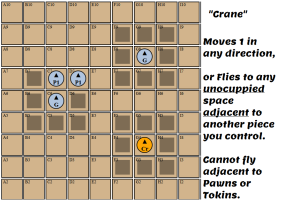
Snake[edit | edit source]
Leopard[edit | edit source]
Wolf[edit | edit source]
Effigy[edit | edit source]
Dragons[edit | edit source]
(Release Version a4.1)
Colorless Dragon[edit | edit source]
Awakening Cost:
Ice Dragon[edit | edit source]
Awakening Cost:
(Spells pending Alpha 4.5 update, coming soon)
Fire Dragon[edit | edit source]
Awakening Cost:
(Spells pending Alpha 4.5 update, coming soon)
Hydra Dragon[edit | edit source]
Awakening Cost:
(Spells pending Alpha 4.5 update, coming soon)
Effigy of a Dragon[edit | edit source]
Used instead of a Dragon in your Army. The Effigy of a Dragon produces 3 Mana Per Turn for its controller. It cannot move, and is not awakened.
Color Variants[edit | edit source]
(Release Version a4.1)
Colorless Variants[edit | edit source]
Blue Variants[edit | edit source]
Red Variants[edit | edit source]
Yellow Variants[edit | edit source]
All Spells[edit | edit source]
(Release Version A4.1)